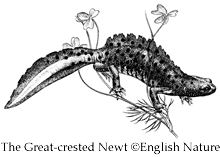Great-crested Newt
Found in the Romney Marsh area. The great-crested newt (Triturus cristatus) is the United Kingdom’s largest newt and is Britian’s most protected amphibian. Adult great-crested newts are easily separated from the two other native species of newts, smooth and palmate, by the size and colouring.
An adult female can measure up to 170mm, while the smooth and palmate newt reach a maximum length of 100mm. The skin of adult crested newts is a black colour and warty in texture, compared to the smooth skin of the other two species of newt. Great-crested newts are bright lollipop orange underneath, with a shaggy crest and a large tail. Through the tail they have a bold silvery streak, however, these are less obvious outside the breeding season.
The Romney Marsh Countryside Partnership surveyed approximately 350 sites within the Romney Marsh Natural Area for great-crested newts between 1998 and 2000 with funding from Natural England.
Great-crested newts were found at 101 of the sites surveyed, with populations ranging from 1 to 358 individuals. The majority of positive sites are waterbodies on grazing marsh or on shingle, whilst only a small number of ponds on arable land support the species.
131 ponds on the Romney Marsh are known to have been lost over the last 16 years due to changing agricultural practices. The RMCP has created 26 new ponds and restored a further 8 with funding from Natural England and Kent County Council through the Interreg II Programme. Many of these new pond have been colonised by great-crested newts.
Maintenance of existing great-crested newt sites on the Romney Marsh is an important part of the RMCP’s annual programme of volunteer tasks, like Romney Warren SSSI, Dungeness NNR and Moneypenny Pits SSSI.
The RMCP is actively involved in raising awareness of the great-created newt and its habitat through guided walks, talks and our wildlife stall at local fairs and public events.

